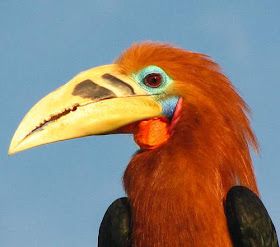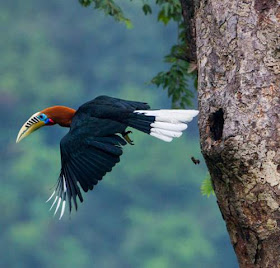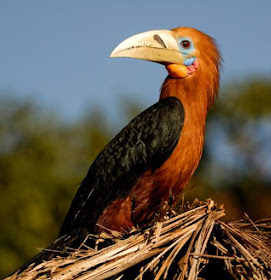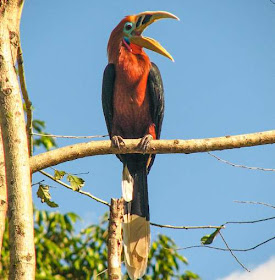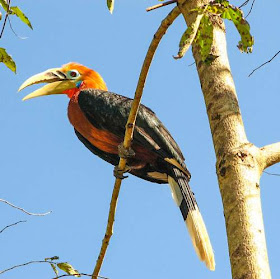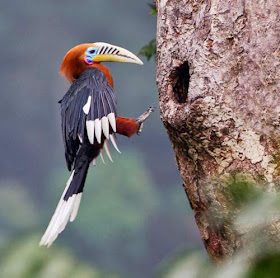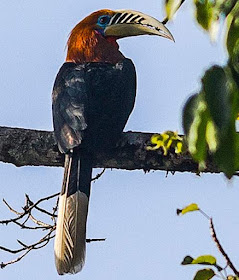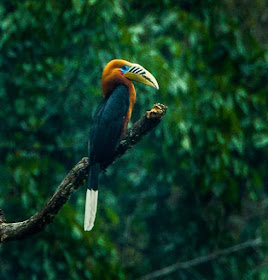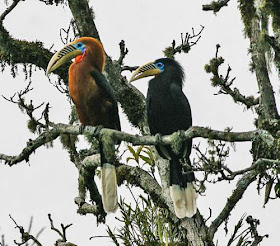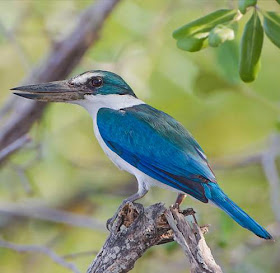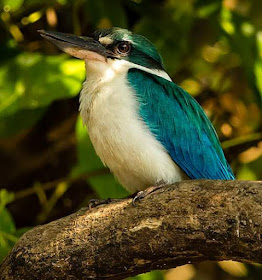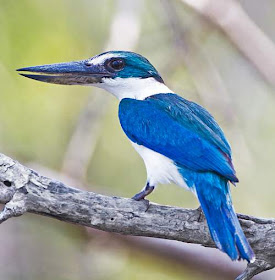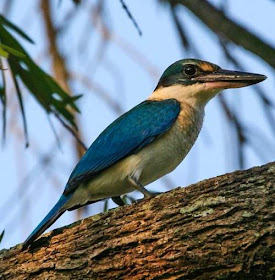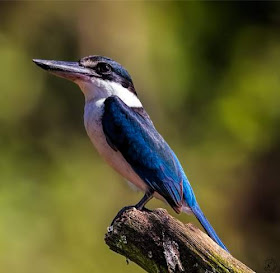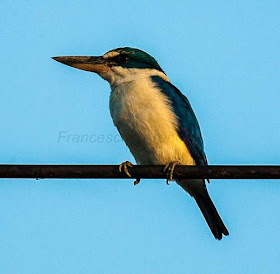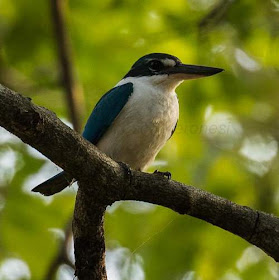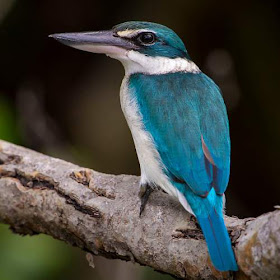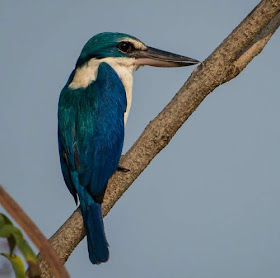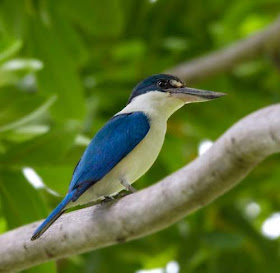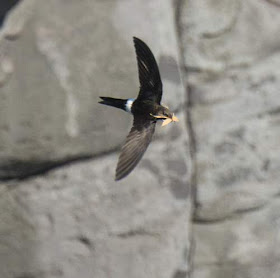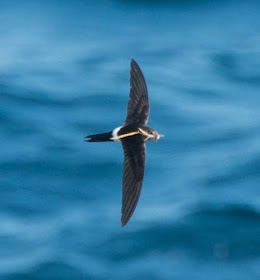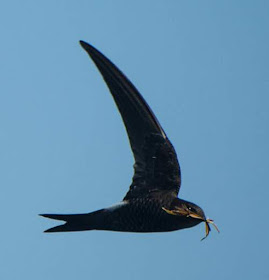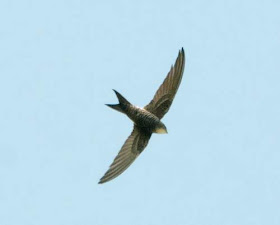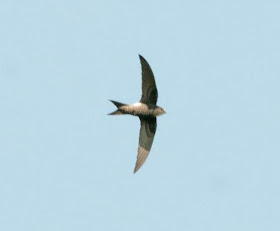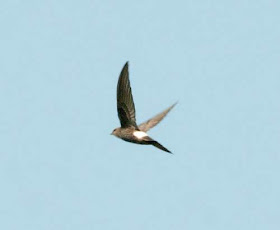Indian birds ›
Pacific swift pictures ›
Collared kingfisher - Todiramphus chloris
The collared kingfisher (
Todiramphus chloris) is a tree kingfisher belonging to the family Alcedinidae.
The collared kingfisher species are distributed in India, Red Sea region, Persian Gulf area, Bangladesh, southeast Asia, several Pacific islands and Australia. There are fifty recognized subspecies of these kingfishers. Some of the subspecies of these kingfishers (
T. c. kalbaensis) are endangered.
Appearance, physical description and identification
The collared kingfisher (
Todiramphus chloris) is a medium-sized kingfisher, measuring 20 to 25 cm in length.
The female collared kingfisher is slightly larger and weighs 55 to 100 grams. The male weighs 50 to 90 grams. The plumage pattern is variable among the subspecies. The upperparts are blue or bluish green and the underparts are white or pale yellowish brown.
There is a white collar around the neck; hence the name. In some collared kingfisher subspecies there is a white stripe over the eye. Some subspecies have a white spot between the eye and the bill. The broad, large bill is black with pale yellow or white patch at the base of the lower mandible.
The irises are dark brown. A black stripe may pass through the eyes. The legs are gray. The female collared kingfisher tends to be greener than the male. Their call is a variety of loud, harsh and metallic “kee-kee-kee-kee” sounds.
 |
| Birds of India - Image of Collared kingfisher - Todiramphus chloris by Sumeet Moghe |
 |
| Indian birds - Picture of Collared kingfisher - Todiramphus chloris by JJ Harrison |
 |
| Birds of India - Photo of Collared kingfisher - Todiramphus chloris by JJ Harrison |
Origin, geographical range and distribution
The collared kingfisher species are distributed in Eritrea, Djibouti, Ethiopia, Saudi Arabia, Oman, United Arab Emirates, India, Bangladesh, Myanmar, Thailand, Cambodia, Laos, Vietnam, Malaysia, Singapore, Brunei, Indonesia, Philippines, Australia, Timor-Leste, Papua New Guinea, Vanuatu, Solomon Islands, Northern Mariana Islands, Micronesia, Fiji and American Samoa.
In India, the collared kingfisher species are distributed in the states of Mizoram, West Bengal, Maharashtra, Goa, Karnataka, Andaman Islands and nicobar Islands.
The Important Bird and Biodiversity Areas (IBA) of collared kingfisher species in Oman are Khor Kalba, Khawr Shinas and Khawr Liwa. The IBA of these species in Saudi Arabia are Khawr 'Amiq, Qishran Bay and Shuqaiq mangrove. The IBA of these collared kingfisher species in United Arab Emirates is Khor Kalba.
Ecosystem and habitat
These collared kingfisher species have moderate forest dependency. These species occur in altitudes from 0 to 1500 meters. The artificial ecosystems of these kingfishers include urban areas, cultivated lands, plantations and rural gardens.
The natural ecosystems of these collared kingfisher species include tropical and subtropical dry forests, tropical and subtropical moist lowland forests, tropical and subtropical shrublands, dry savanna and tropical and subtropical dry grasslands.
The natural wetland ecosystems include tropical and subtropical mangrove vegetation, marine intertidal mud flats, estuaries, marshes, peatlands, rivers, streams and creeks.
Diet and feeding behavior
The diet of these collared kingfisher species is mostly crabs. Small fish, shrimp, crabs, insects, worms, snails, frogs, lizards and small birds are their primary food.
These kingfisher species use open perch for hunting prey. On spotting a prey, it swoops down and catches the prey with bill. The prey is taken to the perch and battered to break carapace and kill it, before swallowing.
Reproduction and breeding habits
The breeding season of these collared kingfisher species in Bangladesh and northeast India is from March to August with a peak period in April and May. The breeding season of these kingfisher species is from April to July in Ethiopia. In United Arab Emirates the laying season is in June.
These collared kingfisher species nest in burrows, excavated in rotten trees, termite mounds or earth bank. The tunnel ends in a broader nesting chamber. They may make use of abandoned woodpecker holes. They lay eggs on the bare ground of the burrow without any lining.
The typical collared kingfisher clutch contains two to seven round, white eggs. Both the parents incubate the eggs. The hatchlings are initially blind and lack down feathers. The chicks fledge in about 44 days. The pair may raise two broods in a year.
Migration and movement patterns
These collared kingfisher species are non-migratory resident birds.
Post breeding, the juveniles may disperse and establish in new locations within the range. They may make local movements for feeding and breeding within their range.
Collared kingfisher - Overview
-
Scientific name: Todiramphus chloris
-
Species author: (Boddaert, 1783)
-
Synonyms/Protonym: Alcedo Chloris Boddaert, 1783, Halcyon chloris, Todirhamphus chloris
-
Family: Alcedinidae › Coraciiformes › Aves › Chordata › Animalia
-
Vernacular names: English: Collared kingfisher, Chinese: 白领翡翠, French: Martin-chasseur à collier blanc, German: Halsbandliest, Spanish: Alción acollarado, Russian: Белошейная альциона, Japanese: ナンヨウショウビン, Malay: Burung Pekaka Bakau
-
Other names: white-collared kingfisher, mangrove kingfisher
-
Distribution: Red Sea region, Persian Gulf region, India, Bangladesh, southeast Asia, Australia
-
Diet and feeding habits: small fish, shrimp, crab, insects, worms, snails, frogs, lizards, small birds
-
IUCN status listing: Least Concern (LC)
Conservation and survival
The global population size of the collared kingfisher (
Todiramphus chloris) has not been quantified. The overall population trend of these species is considered to be decreasing. Throughout its range it is reported to be very widespread and common to abundant. The generation length is 4.8 years. Their distribution size is about 55,200,000 sq.km.
The collared kingfisher (
Todiramphus chloris) does not approach the thresholds for being Vulnerable, either under the range size criterion, or under the population trend criterion or under the population size criterion. The destruction of mangrove forests and trapping for pet trade are the main threats that may endanger the survival of these species.
IUCN and CITES status
The IUCN (International Union for Conservation of Nature) has categorized and evaluated the kingfisher species and has listed it as of "Least Concern". The CITES (Convention on International Trade in Endangered Species of Wild Fauna and Flora) status is ‘Not Evaluated’ for the collared kingfisher (
Todiramphus chloris).
|
Taxonomy and scientific classification of Todiramphus chloris |
|---|
|
Kingdom: | Animalia |
|
Phylum: | Chordata |
|
Class: | Aves |
|
Order: | Coraciiformes |
|
Family: | Alcedinidae |
|
Subfamily: | Halcyoninae |
|
Genus: | Todiramphus |
|
Species: | T. chloris |
|
Binomial name: | Todiramphus chloris |
|
IUCN status listing: |

Least Concern
|
The collared kingfisher (
Todiramphus chloris) is closely related to the Talaud kingfisher (
Todiramphus enigma), Guam kingfisher (
Todiramphus cinnamominus), sacred kingfisher (
Todiramphus sanctus) and chattering kingfisher (
Todiramphus tutus).
Some of the subspecies of
Todiramphus chloris are:
T. c. chloris,
T. c. collaris,
T. c. palmeri,
T. c. azelus,
T. c. chloropterus,
T. c. laubmannianus,
T. c. armstrongi,
T. c. humii,
T. c. occipitalis,
T. c. davisoni,
T. c. vidali,
T. c. kalbaensis, T. c. abyssinicus,
T. c. sordidus,
T. c. pilbara,
T. c. colcloughi,
T. c. teraokai,
T. c. owstoni,
T. c. albicilla,
T. c. orii,
T. c. matthiae,
T. c. nusae and
T. c. novaehiberniae.
1.Image source: https://en.wikipedia.org/wiki/File:White_Collared_Kingfisher.jpg (cropped)
Image author: Sumeet Moghe | License:
CC BY-SA 3.0
2.Image source: https://en.wikipedia.org/wiki/File:Todiramphus_chloris_2_-_Laem_Phak_Bia.jpg (cropped)
Image author: JJ Harrison | License:
CC BY-SA 3.0
3.Image source: https://commons.wikimedia.org/wiki/File:Todiramphus_chloris_-_Laem_Phak_Bia_highlight_reduction.jpg (cropped)
Image author: : JJ Harrison | License:
CC BY-SA 3.0
Current topic in Birds of India: Collared kingfisher -
Todiramphus chloris.
